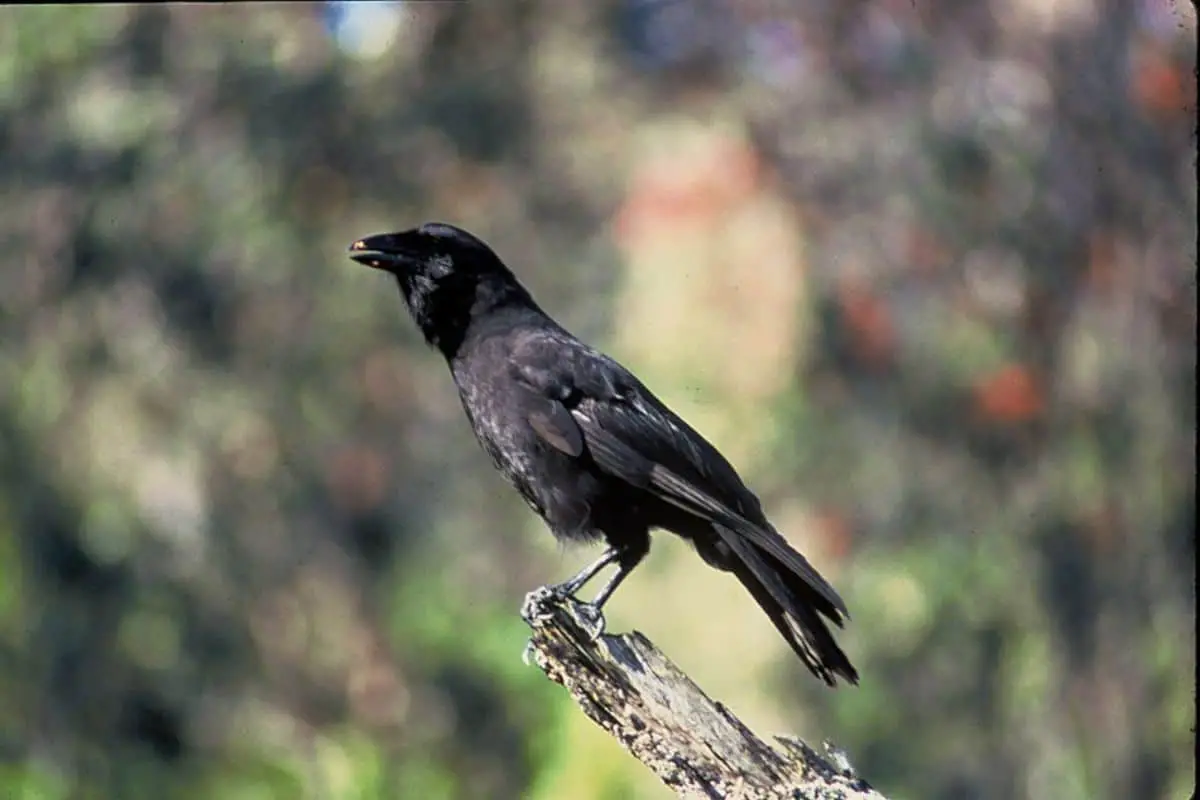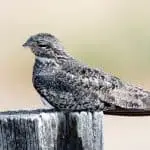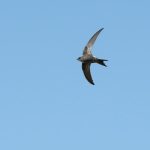Common Name: Hawaiian Crow
Scientific Name: (Corvus hawaiiensis)| Size | Diet | Range in Hawaii | Status in Hawaii |
|---|---|---|---|
| 19 in. - 22 in. | fruits, berries, and seeds | Big Island, Maui, and Kauaʻi | Extinct in the Wild |
The Hawaiian crow, also known as the ʻalalā (Corvus hawaiiensis), is a unique and fascinating bird species that is endemic to Hawaii. With its glossy black feathers and distinctive curved beak, this crow is an important symbol of Hawaiian culture and mythology. However, the Hawaiian crow is also an extinct in the wild (EW) species, with the last known wild individual dying in 2002.
In this article, we’ll explore the fascinating world of the Hawaiian crow and learn more about its unique adaptations and behavior. From its important role in Hawaiian culture to the challenges it faces in modern conservation efforts, we’ll uncover the secrets of this magnificent bird and discover what makes it such a special part of Hawaii’s natural world.
Hawaiian Crow
Appearance
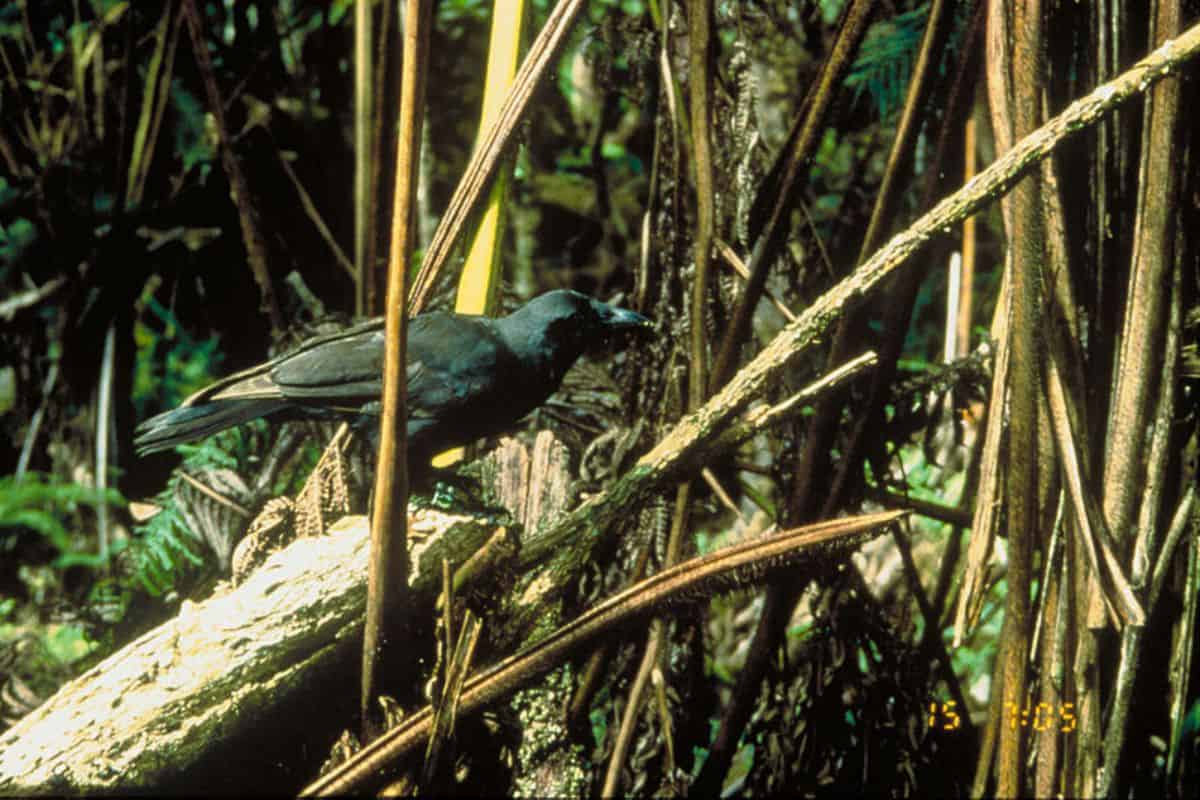
The Hawaiian crow, or ʻalalā, is a striking and distinctive bird with unique physical characteristics. It is a medium-sized corvid species, measuring approximately 19 to 22 inches (48 to 56 centimeters) in length.
The ʻalalā has a glossy black plumage that covers its entire body, including its head, wings, and tail. It has a robust build and a strong, hooked bill that is characteristic of crows. Its legs and feet are also black.
One of the notable features of the Hawaiian crow is its bright blue eyes, which provide a striking contrast against its dark feathers. This eye color is particularly vibrant and adds to the bird’s overall appearance.
Diet
The diet of the Hawaiian crow primarily consists of a diverse range of food items. As an omnivorous bird, its diet includes both plant and animal matter.
The ʻalalā feeds on various fruits, berries, and seeds found within its native forest habitat. It has a particular affinity for the fruits of the native ʻōhiʻa lehua (Metrosideros polymorpha) tree, which make up a significant portion of its diet. It also consumes other native fruits, such as hāwane (Pittosporum spp.) and hōlei (Osteomeles spp.).
In addition to fruits, the Hawaiian crow is known to feed on the nectar of certain flowering plants, utilizing its long bill to reach into the flowers and extract the sweet liquid.
The ʻalalā also scavenges for invertebrates, including insects, spiders, and their larvae. It forages on the forest floor and in tree canopies, using its sharp bill to probe crevices and extract prey.
Furthermore, the Hawaiian crow is an opportunist and may consume small vertebrates, such as lizards, snails, and bird eggs, when the opportunity arises.
Nesting
The nesting behavior of the Hawaiian crow, involves the construction of nests in the branches of trees. These birds build large, sturdy nests made of sticks, twigs, and other plant materials.
The nests are typically located in tall, mature trees within the native forests of Hawaii. The specific tree species used for nesting can vary, but ʻōhiʻa lehua (Metrosideros polymorpha) and koa (Acacia koa) trees are commonly chosen by the Hawaiian crows.
Both male and female ʻalalā actively participate in nest construction. They gather suitable materials and arrange them to create a platform-like structure. The nest is built in a fork or at the top of a tree branch, providing a secure and elevated location for nesting.
Once the nest is complete, the female lays a clutch of one to five eggs. The eggs are pale green or bluish-green in color, with brown speckles. The female incubates the eggs, while the male provides food for her during this period. Incubation typically lasts for about 18 to 21 days.
After the eggs hatch, both parents take on the responsibility of feeding and caring for the nestlings. They bring a variety of food, including fruits, invertebrates, and other small prey, to the nest to feed their hungry offspring. The nestlings grow rapidly under the care of their parents.
Behavior
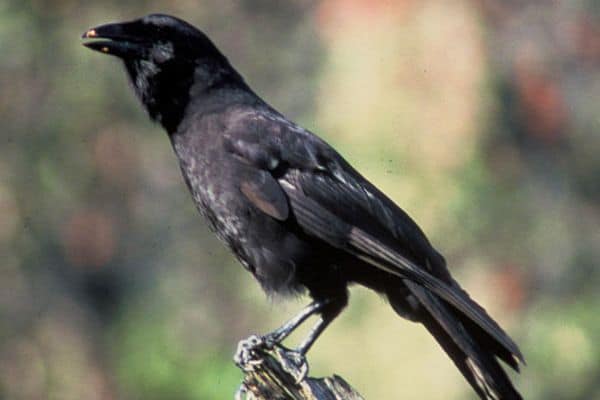
The behavior of the Hawaiian crow is characterized by its social nature, intelligence, and unique adaptations. These birds form social groups, often consisting of small family units or flocks, engaging in cooperative behaviors and communication through a variety of vocalizations and body postures.
The ʻalalā exhibits remarkable intelligence, showcasing problem-solving skills, tool use, and complex cognitive abilities. Their vocal repertoire includes a range of calls, from harsh caws to soft croaks, serving purposes such as territorial defense, flock communication, and mate attraction.
Foraging behavior of the Hawaiian crow is diverse, as they are omnivorous and feed on fruits, seeds, insects, small vertebrates, and other available food sources. They utilize their sharp bills to probe crevices and extract prey, displaying resourcefulness in obtaining their meals.
The ʻalalā’s nesting and breeding behavior involves the construction of large, sturdy nests made of sticks, with both males and females participating in nest-building. The female lays a clutch of eggs, which are incubated by the female while the male provides food and protection. Both parents actively care for the nestlings, ensuring their growth and survival.
In flight, the Hawaiian crow demonstrates agility and strength, maneuvering swiftly through the forest canopy with deep wingbeats and occasional gliding. Unfortunately, the Hawaiian crow is critically endangered, existing only in managed captive populations due to extensive conservation efforts.
Conservationists study their behavior to develop effective strategies for their reintroduction to their native habitat, including habitat restoration, predator control, and behavioral research. Understanding the behavior of the Hawaiian crow is vital for preserving this species and fostering its recovery, safeguarding its place in the unique Hawaiian ecosystem.
Habitat
The preferred habitat of the Hawaiian crow consists of native, mature forests dominated by tree species such as ʻōhiʻa lehua (Metrosideros polymorpha), koa (Acacia koa), and māmane (Sophora chrysophylla). These forests provide essential resources, including nesting sites, food sources, and cover from predators.
The ʻalalā favors areas with a diverse understory, which offers a variety of fruits, seeds, and insects for foraging. Native shrubs, ferns, and other vegetation provide important resources and create a complex habitat structure.
Due to habitat loss and degradation, the Hawaiian crow’s habitat has become significantly fragmented and reduced in size. Introduced species, such as feral pigs and invasive plants, have negatively impacted their habitat by damaging vegetation and altering the forest ecosystem.
Range

The Hawaiian crow is endemic to the Hawaiian Islands and historically had a widespread distribution across the archipelago. It was found on several islands, including Big Island, Maui, and Kauaʻi.
However, due to habitat loss, predation, and other factors, the range of the Hawaiian crow has significantly contracted. Currently, the species is considered extinct in the wild, and efforts are being made to reintroduce it to its native habitat. The reintroduction programs primarily focus on the island of Hawaiʻi, specifically in the Hakalau Forest National Wildlife Refuge and the Puʻu Makaʻala Natural Area Reserve.
Conservation Status
The conservation status of the Hawaiian crow is critically endangered. It is considered one of the world’s most endangered bird species. The Hawaiian crow is currently extinct in the wild, meaning it no longer exists in its natural habitat without direct human intervention.
Historical factors such as habitat loss, predation, and diseases have led to the drastic decline of the Hawaiian crow population. Habitat destruction and degradation have occurred due to deforestation, land development, and the spread of invasive plant species.
Introduced predators, including rats, cats, and mongoose, have preyed upon the birds and their nests, further contributing to their decline. Avian diseases transmitted by introduced mosquitoes have also impacted the species.
Conservation efforts are focused on captive breeding programs to increase the population size and genetic diversity of the Hawaiian crow. Organizations such as the San Diego Zoo Global and the Keauhou Bird Conservation Center are actively involved in breeding and reintroduction initiatives.
The ultimate goal is to establish self-sustaining populations in protected areas, primarily on the island of Hawaiʻi, where the necessary habitat restoration and predator control measures are being implemented.
Interesting Facts
1. Intelligent birds
Hawaiian crows are known for their remarkable intelligence and problem-solving abilities. They have shown tool-use behavior and can solve complex puzzles.
2. Hawaiian mythology
The ʻalalā holds cultural significance in Hawaiian mythology and folklore. It is considered a guardian spirit and has been associated with various deities and legends.
3. Vocalizations
The ʻalalā has a diverse range of vocalizations, including harsh caws, soft croaks, and melodic notes. Vocalizations are used for communication within their social groups.
4. Unique beak shape
The beak of the Hawaiian crow is slightly curved and strong, adapted for probing and foraging in the bark of trees.
Frequently Asked Questions
1. Why is the Hawaiian crow endangered?
The Hawaiian crow is critically endangered primarily due to habitat loss, predation by introduced species, and the spread of avian diseases. These factors have led to a significant decline in the population, resulting in its extinction in the wild.
2. Where can I see Hawaiian crows?
Due to their critically endangered status and current absence in the wild, Hawaiian crows cannot be seen in their natural habitat. However, some captive individuals can be seen in designated facilities, such as the San Diego Zoo Global and the Keauhou Bird Conservation Center in Hawaiʻi.
3. How long do Hawaiian crows live?
Hawaiian crows typically have a lifespan of around 20 to 30 years in captivity. However, their lifespan in the wild is relatively unknown due to their current absence from their natural habitat.
4. Are there any predators of the Hawaiian crow?
Introduced predators pose a significant threat to the Hawaiian crow. Predators such as rats, cats, and mongoose prey upon the birds, their eggs, and nestlings, contributing to their decline.
